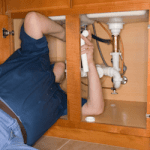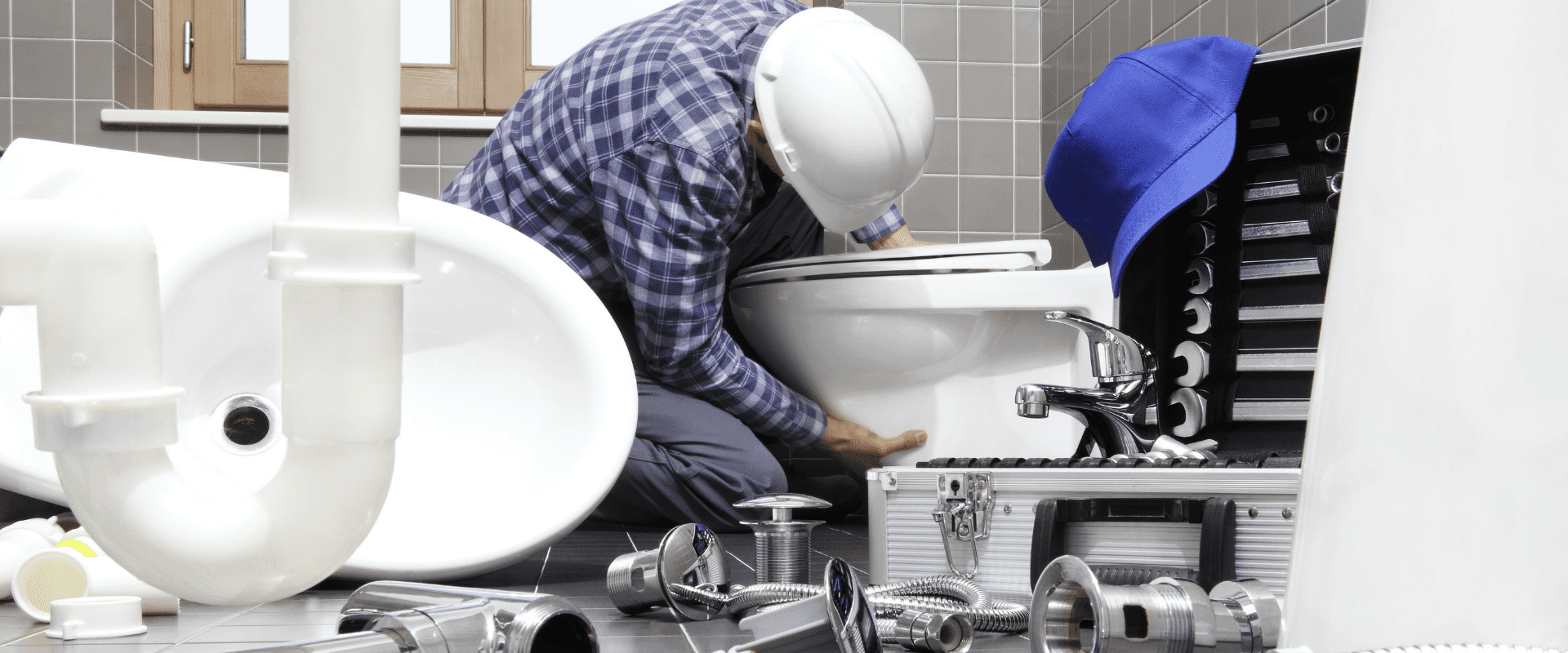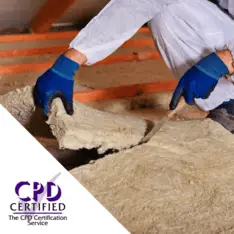Health and Safety for a plumber is a serious business, with many plumbers and heating engineers discovering there is more risk than ever both to themselves and their clients, and current legislation demands that it needs to be controlled.
Update for 2021-22
What does the law say?

As an ex-plumber and trades person myself, I’ve learned quite a bit over the years (usually the hard or unconventional way), but learn it I did.
These days I funnel my energy into work place health and safety and try to make others aware of the dangers so they can return home at night no worse off than when they left in the morning.
As with any trades person, plumbers face a number of job related risks, from manual handling injuries to asbestos exposure. There’s a whole range of things a modern plumber needs to consider when ensuring their safety in the workplace, plus that of their clients and co-workers.
The Health and Safety at Work Act 1974 and the Management of Health and Safety at Work Regulations 1999 place duties on the self-employed to ensure they have assessed the risk to:
- their own health and safety at work.
- the health, safety and welfare of any employees or sub-contractors.
- the health and safety of other people they work with (including the client and any others in the vicinity that maybe affected by their acts or omissions).

And if you are an employed plumber, you don’t get away Scott free either.
The health and safety at Work Act also lays obligations on employees under section 7 of the act (Duties of Employees).
The section simply expects you to take reasonable care of yourself and of others who may be affected by your actions, whether directly or indirectly.
How complicated is a risk assessment?
Carrying out a risk assessment whether you are a contractor or employee should really be second nature.
All that’s required before you make a start is that you take a step back to weigh up the job and think about what might cause harm, and who might be affected, then decide whether you are doing enough to prevent that harm.
After all, you wouldn’t attend a reported gas leak in a dark room and immediately get your cigarette lighter out to see where the problem is. You’d definitely weigh up the risks of that one first and decide what could be done to prevent harm.
Once you’ve identified the risks, all that is then required is you prioritise and either remove the risk or put in place sensible measures to control the risk.

Again, using our gas leak example the first priority would be the risk of explosion. Therefore, the sensible control measure would be to isolate the gas either at source or to the appliance.
Depending upon the occupancy, your second priority might be harm to the occupants by explosion from the residual gas or poisoning, so your control measure might be to ask everybody to go outside and stay away from windows.
And thirdly, in order to mitigate any harm to others and yourself, your control measure might be to open windows and leave the premises yourself as quickly as possible until the room or building has fully vented.
That scenario is extreme of course, but without too much thought that is the sequence of events most plumbers or heating engineers would take, so why have a cavalier attitude towards safety when approaching any other task?
Staying safe is simply about acting responsibly and applying a little thought before starting the job.
What are the risks to plumbers?
There are various issues that plumbers face on a daily basis.
This includes:
Exposure to life threatening materials such as lead or asbestos.
Tip: Before breaking out wall panels or accessing service ducts check to see if there is an asbestos register on site. If in doubt work around it or leave it in place. Do not smash out boards or panels that look like they might contain asbestos or are known to be made from asbestos.
Asbestos was used in many common things such as ceiling tiles, Bakelite toilet cisterns, floor tiles, insulation etc. Wear a correct fitting mask of high quality filtration and make yourself aware of the dangers by getting on an up to date asbestos awareness training course.
Always wear gloves and goggles as well when breaking out or creating access.
Asbestos Awareness E-Learning
Approved & CPD Accredited
Exposure to bio hazards, including mould raw sewage, rats (Weil’s Disease), pigeon droppings and other vermin.

Tip: Wear gloves and fully fitting overalls when accessing lofts or crawl spaces. Wash hands regularly and especially before eating, drinking or smoking. Change overalls regularly or use disposable ones. Wash overalls separately from the family washing. Wear a good fitting dust mask with a high filtration such as FP3. If possible, have a mask face fit test to ensure you are wearing the correct fitting RPE for the shape of your face.
Tetanus and Hepatitis A, B and C are easily contracted from sewage and contaminated soil so make sure your PPE is always to hand and take a visit to your doctor for up to date jabs.
Exposure to electrical installations and exposed or badly wired cables (usually from DIY works).
Tip: During rip out works always assume any cables you come across are live. Isolate at the mains supply before working near them. When climbing into lofts be aware of putting your hand onto exposed cables or unprotected ceiling spot fittings. Always be aware that a home DIY electrician may have been active in the property and just because the fuse board switch says “downstairs sockets”, the one you are looking at could have been spurred off a cooker circuit!. Always test for dead before continuing and wear appropriate footwear and gloves where possible. They might just protect you from making a circuit to earth.
Exposure to noise such as drain cleaning equipment or power tools in enclosed spaces.
Often, hearing will fully recover from a short burst of loud noise, but the real danger is being exposed to noise over long periods of time. This sort of exposure eventually causes damage to the tiny hairs that line the ear canal, and once they are damaged they never recover. Always try to use ear defenders or a good quality ear plug when working in an environment with lots of prolonged background noise.
Working at heights.
Working at height can mean working off ladders, step ladders, in a loft space or above an open pit for example. The obvious dangers from falling are broken bones, incapacity or even death. But working off ladders for long periods of time can cause muscle strain in the legs, foot problems and back pains.
Tip: Minimise working from ladders to jobs of short and light duration. Try to do as much from the ground as possible first. If the work requires prolonged periods of working at height or heavy lifting, consider alternative methods such as a scaffold tower or a powered access platform.
When working above ceilings, ensure the area is well lit and keep it tidy to remove any trip hazards. Try to lay solid boards across the joists to act as a temporary floor. Clear the insulation away so you can see the joists that will take your weight.
Attend a working at height course to maintain awareness of equipment, the dangers and how you can work safely.
Slips, trips and falls on wet surfaces or unlit areas.
Slips and trips can catch us out at any time, but when you are working with liquids it very quickly becomes a real problem.
Tip: Purchase the best footwear you can afford with a sturdy non-slip sole, arch protection and upper foot protection.
- Ensure they fit correctly and are properly fastened. You’ll wear this footwear for the majority of your waking hours, so you need to be comfortable and they needs to protect you from slipping and other hazards.
- Soak up spills immediately. Water has a really annoying way of spreading around fast.
- Keep your work area tidy, including managing cables from power tools.
- Ensure the area you are working in is well lit and free from obstacles.
- Be aware of loose or ripped floor coverings and loose or damaged stair nosing.
- Old properties can have differing floor levels. It’s easy to stumble when you are carrying a copper cylinder and the floor level suddenly changes.
- Take extra care when working in icy or wet weather. Be aware that ladder rungs get very slippery when wet or muddy. Just take things a bit slower.
Working in awkward positions or confined spaces such as lofts, airing cupboards and under floors.

While it’s understood that home and building owners don’t want ugly pipework on display, or a water tank dominating a space that could be used as storage, it’s really inconvenient for plumbers.
Instead, plumbers often have to double up as a contortionist to repair or replace services in tiny cupboards, low loft spaces, under floorboards and sinks.
This poses a real threat of muscular skeletal injuries, head injuries, back and neck problems, as well as cuts and abrasions from slipped tools.
Tip: If working in a tight space take a break at least every thirty minutes. Stand up. move around, stretch and have some refreshment.
Ensure the tools you are using are in good condition. Nothing makes the job harder than blunt or worn tools. As well as getting the job done much easier, you’ll save yourself lots of grief from skinned knuckles, cuts and abrasions from slipping spanners, wrenches and screwdrivers.
Lone working in empty buildings.
Empty buildings can be both a blessing and a nightmare. While it’s great to have free reign of a building and not have to worry about damaging decoration and moving furniture around they come with their own hazards. The main one being lone working and having an accident such as falling off a ladder, a serious cut, or sudden ill health such as a heart attack or black out.
The likely chance is that you may be rendered unconscious with little hope of being discovered until you’ve failed to return home.
Tip: Ensure somebody always knows where you are working and what time you expect to finish. Employers have a duty of care towards lone workers and should have a method in place for regular contact. Make sure that you have regular contact with your office or somebody who can raise the alarm should they not be able to contact you.
Carry a mobile phone everywhere you go in the building. Even to the toilet.
How many times do you walk into an empty building and the first thing you come across is the radio blaring on the window sill and a mobile phone next to it.
It’s going to be of little use on the window sill when your legs are dangling through the upstairs ceiling.
Lastly, make sure the phone is fully charged in the morning and topped up with credit if it’s a pay as you go.
Manual handling injuries from lifting heavy or awkward shaped tanks and cylinders.
Manual handling injuries have a major impact on all workplaces and sectors. The cost to the economy and business is countless millions every year from lost production, injury claims, NHS treatment, not to mention the personal misery and financial loss to the sufferer.
From lifting heavy or awkwardly shaped equipment – to sitting badly – to manoeuvring materials and carrying out repetitive motions, the risks are endless.
Tip: Give some thought to the task before attempting it.
- Keep the weight close to the body when carrying.
- Break the load into smaller pieces.
- Use team lifting.
- Don’t attempt to lift beyond your capacity.
- Take regular breaks if working awkwardly
- Get some manual handling awareness training.
Covid 19 – Coronavirus & Variants (update 2021-22)
As if there’s not enough to cope with, along comes the Corona virus.
We all have a duty to keep ourselves safe, the people we work with, our families and the wider community in general.
Plumbers and trades people are regarded as key workers and have a rightful duty to keep our economy and communities safe and operating.
When out and about consider the following precautions.
- Wear a face and nose covering when out in public and working with your customers, colleagues, and other workers.
- Regularly wash or sanitise your hands.
- Regularly clean common touchpoints or shared tools with a hard surface sanitiser.
- Try to keep your distance wherever possible. If you do need to come into close contact, then try to work side by side rather than face to face.
- That said, always seek help for moving heavy objects, but exercise common sense and wear a face covering.
- If working on site, or in a busy environment, try to minimise unnecessary moving around, and stagger break times where possible.
Final thoughts.
We’ve taken a brief look at the typical hazards that plumbers face on a daily basis. It’s not an exhaustive list by any means, but I hope it makes at least somebody think about how easily they could be harmed or become unwell, and the financially consequences.
Even if it prevents one plumber or trades person from injury then it was worth writing.
If you want to add your own thoughts or experiences on the subject then please leave a comment below. We love to hear from you.



